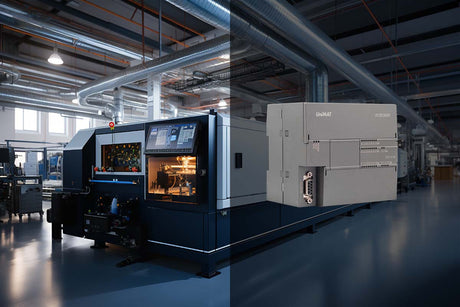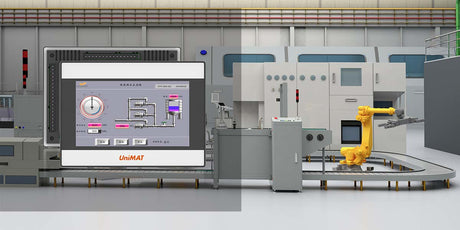PLC is a new generation of general industrial control device based on microprocessor,integrating computer technology,automatic control technology and communication technology,using"natural language"programming for control process and user,adapting to industrial environment,simple to understand,easy to operate and highly reliable.PLC is a general automatic control device with microprocessor as the core developed on the basis of relay sequential control.
What is a PLC?
Programmable controller is a digital operation electronic system designed for application in industrial environment.It uses programmable memory to store operation instructions such as logical operation,sequential control,timing,counting and arithmetic operation,and controls various types of machinery or production processes through digital and analog input and output.Programmable controller and its related peripherals should be designed according to the principle of easy to form an integral whole with industrial control system and easy to expand its functions.

What types of PLCs are there?
PLC products come in many varieties,and their specifications and performance vary.PLCs are usually roughly classified according to their different structural forms,functional differences,and the number of I/O points.
According to the structural form of PLCs,PLCs can be divided into two categories:integral and modular.

(1)Integral PLC
Integral PLCs are components such as power supply,CPU,and I/O interface that are all installed in one chassis,as shown in the figure.It has the characteristics of compact structure,small size,and low price.Small PLCs generally adopt this integral structure.Integral PLCs are composed of basic units(also known as host)with different I/O points and expansion units.The basic unit has a CPU,I/O interface,an expansion port connected to the I/O expansion unit,and an interface connected to a programmer or EPROM writer.The expansion unit only has I/O and power supply,but no CPU.The basic unit and the expansion unit are generally connected by a flat cable.Integral PLCs can also be equipped with special function units,such as analog units,position control units,etc.,to expand their functions.
(2)Modular PLC
The modular PLC makes each component of the PLC into several separate modules,such as the CPU module,I/O module,power module(some are included in the CPU module)and various functional modules.The modular PLC consists of a frame or baseboard and various modules,and the modules are installed on the sockets of the frame or baseboard,as shown in the figure.The characteristics of this modular PLC are flexible configuration,and different scale systems can be selected according to needs.It is also easy to assemble,expand and maintain.Large and medium-sized PLCs generally adopt a modular structure.
Classification by I/O points
Based on the number of I/O points of the PLC,PLCs can be divided into three categories:small,medium and large.The I/O points of a small PLC are less than 256,the I/O points of a medium-sized PLC are between 256 and 2048,and the I/O points of a large PLC are greater than 2048.
What are the characteristics of PLC?
PLC is a general industrial automatic control device developed with microprocessor as the core,integrating computer technology,automatic control technology and communication technology.It has a series of advantages such as high reliability,small size,strong function,simple program design,flexible and convenient maintenance.Therefore,it is widely used in metallurgy,energy,chemical industry,transportation,electricity and other fields,and has become one of the three pillars of modern industrial control(PLC,robot and CAD/CAM).

Functions of PLC
(1)Switching logic control
(2)Analog control
(3)Process control
(4)Timing and counting control
(5)Sequential control
(6)Data processing
(7)Communication and networking
What does PLC do?
The working mode of PLC scanning is mainly divided into three stages,namely the input sampling stage,the user program execution stage and the output refresh stage.
1.Input sampling stage
In the input sampling stage,the PLC reads all input states and data in sequence in a scanning manner and stores them in the corresponding units in the I/O image area.After the input sampling is completed,it enters the user program execution and output refresh stages.In these two stages,even if the input state and data change,the state and data of the corresponding units in the I/O image area will not change.Therefore,if the input is a pulse signal,the width of the pulse signal must be greater than one scan cycle to ensure that the input can be read in any case.
2.User program execution stage
In the user program execution stage,the PLC always scans the user program(ladder diagram)in order from top to bottom.When scanning each ladder diagram,the control circuit composed of the contacts on the left side of the ladder diagram is always scanned first,and the control circuit composed of the contacts is logically operated in the order of left first,right second,top first,bottom second;then,according to the result of the logical operation,the state of the corresponding bit of the logic coil in the system RAM storage area is refreshed,or the state of the corresponding bit of the output coil in the I/O image area is refreshed,or it is determined whether to execute the special function instruction specified by the ladder diagram.That is,during the execution of the user program,only the state and data of the input point in the I/O image area will not change,while the state and data of other output points and soft devices in the I/O image area or the system RAM storage area may change,and the program execution results of the ladder diagram arranged above will affect all the ladder diagrams arranged below that use these coils or data;on the contrary,the state or data of the refreshed logic coils of the ladder diagram arranged below can only affect the ladder diagram arranged above it in the next scanning cycle.
3.Output refresh phase
When the user program scan is completed,the PLC enters the output refresh phase.During this period,the CPU refreshes all output latch circuits according to the corresponding status and data in the I/O image area,and then drives the corresponding peripherals through the output circuit.Only then is the real output of the PLC.
Where is PLC used?
Currently,PLC has been widely used in various industries such as steel,petroleum,chemical industry,electricity,building materials,machinery manufacturing,automobiles,textiles,transportation,environmental protection,culture and entertainment.

The difference between PLC and industrial computer
PLC controls mechanical automation through specific programming,and industrial computer can be understood as our common computer,but it is used in industrial environment;the main difference between the two is that PLC has relatively simple functions,and industrial PC has richer functions,but it can control automation equipment in industrial environment;in fact,PLC has low cost and industrial computer has high price.
How to choose PLC?
PLC can be divided into modular PLC and integrated PLC according to the structure,and can be divided into small,medium and large PLC according to the number of I/O points.Before choosing a suitable PLC,you must first clarify your own needs,including:the number and type of devices to be controlled,determine the number of input and output points of the PLC,and other equipment installation environment,networking communication function,storage capacity,and cost budget;

There are several PLC programming languages.Unimat PLC programming language supports standard programming languageson the market,and our PLC is perfectly compatible with Siemens PLC,giving customers more choices without changing the original programming logic.
Unimat has been focusing on automation for 20 years.Our PLC/HMI supports free prototype testing.If you have PLC/HMI needs,you are also welcome to contact us for a quote.









